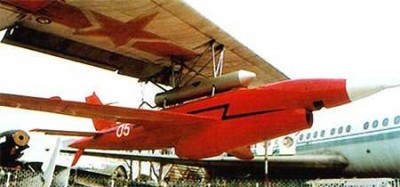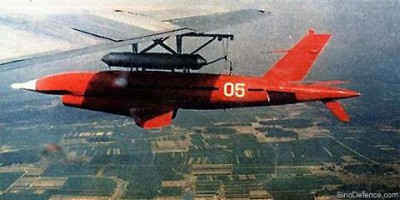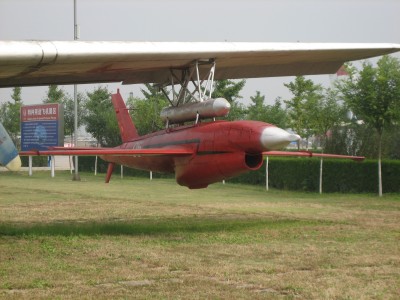| Název: Name: | WZ-5 | WZ-5 |
| Originální název: Original Name: | 无侦-5 / 长虹”1号 | |
| Kategorie: Category: | bezpilotní průzkumný letoun | unmanned reconnaissance aerial vehicle |
| Výrobce: Producer: | DD.MM.1981-DD.MM.198R Beijing Institute of Aeronautics and Astronautics, Beijing | |
| Období výroby: Production Period: | DD.MM.1981-DD.MM.198R | |
| Vyrobeno kusů: Number of Produced: | ? | |
| První vzlet: Maiden Flight: | 28.11.1972 | |
| Základní charakteristika: Basic Characteristics: | ||
| Vzlet a přistání: Take-off and Landing: | vypouštěný z letadla, přistání na padáku | air-launched, landing on a parachute |
| Uspořádání křídla: Arrangement of Wing: | jednoplošník | monoplane |
| Uspořádání letounu: Aircraft Concept: | klasické | conventional |
| Podvozek: Undercarriage: | jiný | other |
| Přistávací zařízení: Landing Gear: | žádné | none |
| Technické údaje: Technical Data: | ||
| Hmotnost prázdného letounu: Empty Weight: | 1060 kg | 2337 lb |
| Maximální vzletová hmotnost: Maximum Take-off Weight: | 1700 kg | 3748 lb |
| Rozpětí: Wingspan: | 9,76 m | 32 ft ¼ in |
| Délka: Length: | 8,97 m | 29 ft 5 ⅛ in |
| Výška: Height: | 2,18 m | 7 ft 1 ⅞ in |
| Plocha křídla: Wing Area: | ? m2 | ? ft2 |
| Pohon: Propulsion: | ||
| Kategorie: Category: | jednoproudový | turbojet |
| Počet motorů: Number of engines: | 1 | |
| Typ: Type: | WP-11 (tah 8,33 kN) | WP-11 (8,33 kN) |
| Objem palivových nádrží: Fuel Tank Capacity: | 620 kg | 1367 lb |
| Výkony: Performance: | ||
| Maximální rychlost: Maximum Speed: | 800 km/h v 17500 m | 497 mph in 57415 ft |
| Cestovní rychlost: Cruise Speed: | ? km/h v ? m | ? mph in ? ft |
| Operační dostup: Service Ceiling: | ? m | ? ft |
| Maximální dolet: Maximum Range: | 2500 km | 1553 mi |
| Vytrvalost: Endurance: | 3 h | |
| Výzbroj: Armament: | žádná | none |
| Vybavení: Equipment: | 5 x optická, elektrooptická, alebo infračervená kamera, celkom 65 kg | 5 x optical, electrooptical or infrared camera |
| Uživatelské státy: User States: | | |
| Poznámka: Note: | Označenie pre export: ChangHong-1 (CH-1) | Export name: ChangHong-1 (CH-1) |
| Zdroje: Sources: | www.sinodefence.com archív autora | |
Peking WZ-5
Beijing WZ-5
无侦-5 / 长虹”1号
WuZhen-5 (WZ-5) - unmanned reconnaissance aerial vehicle (URAV), a reverse engineered Chinese copy of an American unmanned aerial vehicle AQM-34N "Firebee". The export designation of the composition is ChangHong-1 (CH-1).
Manufacturer: Beijing Institute of Aeronautics (now Beijing University of Aeronautics & Astronautics)
WZ-5 was the first and currently the only operationally used strategic jet unmanned reconnaissance vehicle in the Chinese Air Force ( PLAAF).
History: Several US drones AQM-34N "Firebee" used by the US Strategic Air Force Command was between 1964 - 1968 ([ note here the data differ from the data for AQM-34N "Firebee", which was allegedly used in Vietnam only in the years 1967-1971) shot down by the Chinese Air Force on their reconnaissance missions over China and North Vietnam. At least one of the shot down machines fell into Chinese hands relatively undamaged. Using undamaged parts from other acquired machines and replacing some parts with Chinese, scientists and technicians from the Beijing Institute of Aviation were able to operate and then subject to flight tests a copy of AQM-34N "Firebee".
Based on the experience gained in the completion of the device and the use of reverse engineering, the development of our own device based on this type began in 1969. The flight of the first prototype WZ-5 was made on 28.11.1972. Individual tests and continuous improvement followed. The first combat deployment, then still pre-production machines, was carried out in 1979 during Sino-Vietnamese border conflict. The unmanned vehicle WZ-5 then demonstrated its capabilities as an irreplaceable helper in obtaining information (IMINT) and it was decided to introduce it into service. It was officially introduced into service in 1980.
Description:
WZ-5 is a mid-plane with wings facing backwards. The jet engine is built into the lower part of the fuselage with an oval intake opening at the front and an outlet at the rear. The hull is round in cross-section, tapering backwards. The carrier was originally a bomber of Soviet origin Tu-4 "Bull", currently developed and put into service carrier based on the turboprop aircraft Y-8 (licensed production of An-12 "Cub") referred to as Y-8E.
During a combat mission, the unmanned vehicle is first transported by air to the vicinity of the deployment at an altitude of 4000-5000 m. Following disconnection from the carrier it automatically ascends to an operating height of 17500 m. After reaching the target zone, the device is controlled by the autopilot on the basis of pre-programmed flight parameters (altitude, speed, course, speed, flight time). At the end of the mission, the vehicle returns to the starting area, where it lands on a parachute after switching off the engine on the basis of the remote control.
The fuselage is divided into six sections - radar, optical reconnaissance equipment, fuel system, engine part, avionics and parachute part. The device has 5 positions for the placement of optical (electro-optical, infrared) cameras. Photographs are stored on a recording medium (photographic film) placed inside the fuselage.
The basic variant WZ-5 cannot currently be compared with modern reconnaissance drones. Limited infrared reconnaissance capabilities allow efficient reconnaissance only in daylight, the non-existent digitization of images and subsequent data communication do not allow the transmission of detected data to command posts in real time. Fixed programming of the flight path does not allow to change the flight parameters depending on the conditions and activities of the enemy. These shortcomings will be gradually remedied during the planned modernization.
Drive:
WZ-5 is powered by a jet engine WP-11 with a thrust of 8.33 kN.
Manufacturer: Beijing Institute of Aeronautics (now Beijing University of Aeronautics & Astronautics)
WZ-5 was the first and currently the only operationally used strategic jet unmanned reconnaissance vehicle in the Chinese Air Force ( PLAAF).
History: Several US drones AQM-34N "Firebee" used by the US Strategic Air Force Command was between 1964 - 1968 ([ note here the data differ from the data for AQM-34N "Firebee", which was allegedly used in Vietnam only in the years 1967-1971) shot down by the Chinese Air Force on their reconnaissance missions over China and North Vietnam. At least one of the shot down machines fell into Chinese hands relatively undamaged. Using undamaged parts from other acquired machines and replacing some parts with Chinese, scientists and technicians from the Beijing Institute of Aviation were able to operate and then subject to flight tests a copy of AQM-34N "Firebee".
Based on the experience gained in the completion of the device and the use of reverse engineering, the development of our own device based on this type began in 1969. The flight of the first prototype WZ-5 was made on 28.11.1972. Individual tests and continuous improvement followed. The first combat deployment, then still pre-production machines, was carried out in 1979 during Sino-Vietnamese border conflict. The unmanned vehicle WZ-5 then demonstrated its capabilities as an irreplaceable helper in obtaining information (IMINT) and it was decided to introduce it into service. It was officially introduced into service in 1980.
Description:
WZ-5 is a mid-plane with wings facing backwards. The jet engine is built into the lower part of the fuselage with an oval intake opening at the front and an outlet at the rear. The hull is round in cross-section, tapering backwards. The carrier was originally a bomber of Soviet origin Tu-4 "Bull", currently developed and put into service carrier based on the turboprop aircraft Y-8 (licensed production of An-12 "Cub") referred to as Y-8E.
During a combat mission, the unmanned vehicle is first transported by air to the vicinity of the deployment at an altitude of 4000-5000 m. Following disconnection from the carrier it automatically ascends to an operating height of 17500 m. After reaching the target zone, the device is controlled by the autopilot on the basis of pre-programmed flight parameters (altitude, speed, course, speed, flight time). At the end of the mission, the vehicle returns to the starting area, where it lands on a parachute after switching off the engine on the basis of the remote control.
The fuselage is divided into six sections - radar, optical reconnaissance equipment, fuel system, engine part, avionics and parachute part. The device has 5 positions for the placement of optical (electro-optical, infrared) cameras. Photographs are stored on a recording medium (photographic film) placed inside the fuselage.
The basic variant WZ-5 cannot currently be compared with modern reconnaissance drones. Limited infrared reconnaissance capabilities allow efficient reconnaissance only in daylight, the non-existent digitization of images and subsequent data communication do not allow the transmission of detected data to command posts in real time. Fixed programming of the flight path does not allow to change the flight parameters depending on the conditions and activities of the enemy. These shortcomings will be gradually remedied during the planned modernization.
Drive:
WZ-5 is powered by a jet engine WP-11 with a thrust of 8.33 kN.
author's archive, www.sinodefence.com
Reklama
Join us
We believe that there are people with different interests and experiences who could contribute their knowledge and ideas. If you love military history and have experience in historical research, writing articles, editing text, moderating, creating images, graphics or videos, or simply have a desire to contribute to our unique system, you can join us and help us create content that will be interesting and beneficial to other readers.
Find out more

